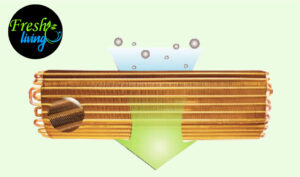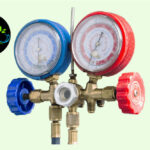
Table of Contents
What is Gold Fin Technology in Air Conditioning ?
The technology of an air conditioner is based on the physical law that when a liquid turns into a gas, it absorbs heat. An air conditioner cools air by converting a chemical known as refrigerant from the liquid state to the gaseous state and back to liquid over and over again in a never-ending cycle. It has four main parts: evaporator, compressor, condenser and expansion valve.
A fan inside the air conditioner draws in hot air from the room and blows it over the evaporator coils (also called fins) which causes the liquid refrigerant inside the coils to absorb the heat and turn into gas. The gas then moves into the compressor which increases the pressure of the gas to convert it back to liquid. As the pressurized gas passes through the condenser coils, it becomes liquid again while simultaneously releasing a lot of heat. A second fan blows over the condenser to dissipate the heat to the outdoors. The liquid refrigerant travels back to the indoor unit through the expansion valve which regulates its flow from the condenser to the evaporator.
Corrosion in air conditioners :
Because of the way an air conditioner works, the condenser is always located outside the house which exposes it to the elements. The all-weather enclosure it is housed in also offers only partial protection and it is still vulnerable to rain, dust and air pollution.
Due to condensation, the condenser coils are always covered with water droplets which contain atmospheric salts and acids. These salts and acids, although present in trace amounts in the air, are highly corrosive and can cause great damage to both the condenser and the evaporator coils, not to mention the cabinet and the fans. As the water settles on the surface of the coils, it deposits large amounts of salts and acids, which over time form a thick layer over the coils, restricting air flow and inhibiting heat exchange between the coil and the air.
This problem is compounded by the fact that fins are delicate and bend easily. If, for some reason, the fins get bent, the space between them closes up, making it further difficult for air to pass freely. Consequently, the air conditioner has to work harder to pump air through the narrow spaces for thermal transfer. This increases the strain on the air conditioner and it wears down quickly, leading to frequent repairs and a higher operating cost.
The issue of corrosion is further aggravated by humidity. Regions that have high levels of humidity such as coastal belts and places that receive plenty of rainfall throughout the year have air that is laden with water vapor which only hastens the process of rusting.
Condenser and evaporator coils are shaped like fins. They are a closed system of refrigerant-filled thin tubes folded repeatedly in patterns with space in between for air to pass and thermal transfer to take place. The coils are mostly made of copper or aluminum, although copper is a more preferred choice for a number of reasons.
First, copper is a better conductor of heat and makes for faster exchange of heat and rapid cooling. It is more malleable and has a high stress level before breaking. It also has a higher tensile strength than aluminum. But, copper is more expensive which is why most air conditioner manufacturers use a combination of the two metals. They weld the aluminum to the copper tubes which reduces the cost of production.
But, the technique gives rise to an undesirable condition known as galvanic corrosion which can be averted if only one metal is used instead of two to make the fins.
Gold Fin Technology: How it prevents corrosion in Air Conditioners

The best way to beat corrosion is to coat the condenser and evaporator with weather-resistant materials. Gold Fin technology is one of the most common ways to weatherproof an air conditioner. The fins are coated with an anti-corrosion gold nano coating synthesized from titanium dioxide.
The nano-sized molecules of the compound adhere closely to the surface of the fins, forming a physical barrier between the fin and the environment. Any water that forms on the fins outer surface, easily trickles off and is drained out through the outlet. Gold Fin technology prevents deposition of corrosive salts and acids. It also keeps the fins free of dust and debris. The fins don’t get clogged and air flow stays normal.
Brands like IFB use a titanium dioxide coating to form a waterproof shield over the evaporator. It protects the fins from rusting and corrosion, and improves their heat exchange efficiency. It also prevents bacteria, fungi and viruses from breeding inside the air conditioner.
LG Electronics uses an Auto Clean mechanism in addition to their Gold Fin technology. This mechanism sanitizes the inside of an air conditioner by drying the coils. An ionizer releases nano ions which sterilizes the coils in order to inhibit growth of harmful germs.
In humid environments, golf fin technology is quite helpful. It plays a key role in keeping up the efficacy of the machine. It speeds up the defrosting process so that the air cools faster. It also prolongs the life of the air conditioner by fortifying it against moisture, salts, acids, dust and mold.
An alternative to Gold Fin technology is Blue Fin technology. This technology involves treating the fins with a blue coating of epoxy and is a kind of conformal coating. Epoxy is a corrosion-resistant material that does not allow water vapor to settle on the fins. It has a low surface tension which causes water droplets to slide off. It repels moisture and prevents rusting.
Epoxy is unaffected by atmospheric salts and acids. It enhances the efficiency of the air conditioner and conserves electricity. Companies like Daikin double-coat their fins with a corrosion-resistant acrylic resin and a hydrophilic film to make them more long-lasting. Acrylic resins and hydrophilic coatings have weather-resistant properties and protect the fins from environmental decay.
Pro Tips : Check blue fin technology and micro channel condenser coil technology in details in our recommended study. Air conditioning systems are better option for humid summers in India. For dry summer you can consider buying air coolers in India.


